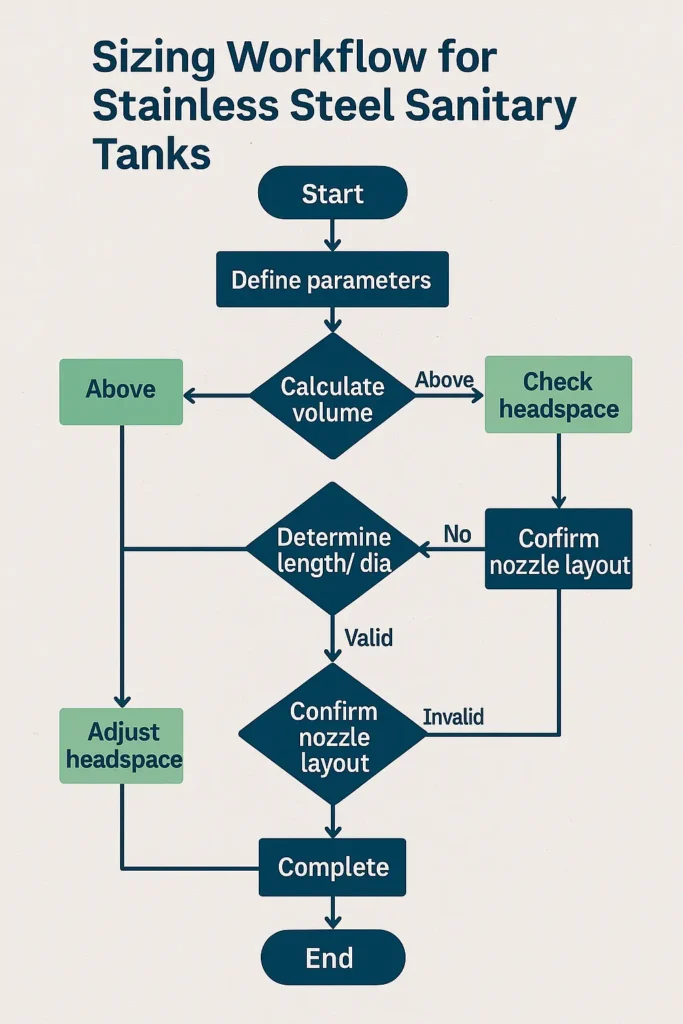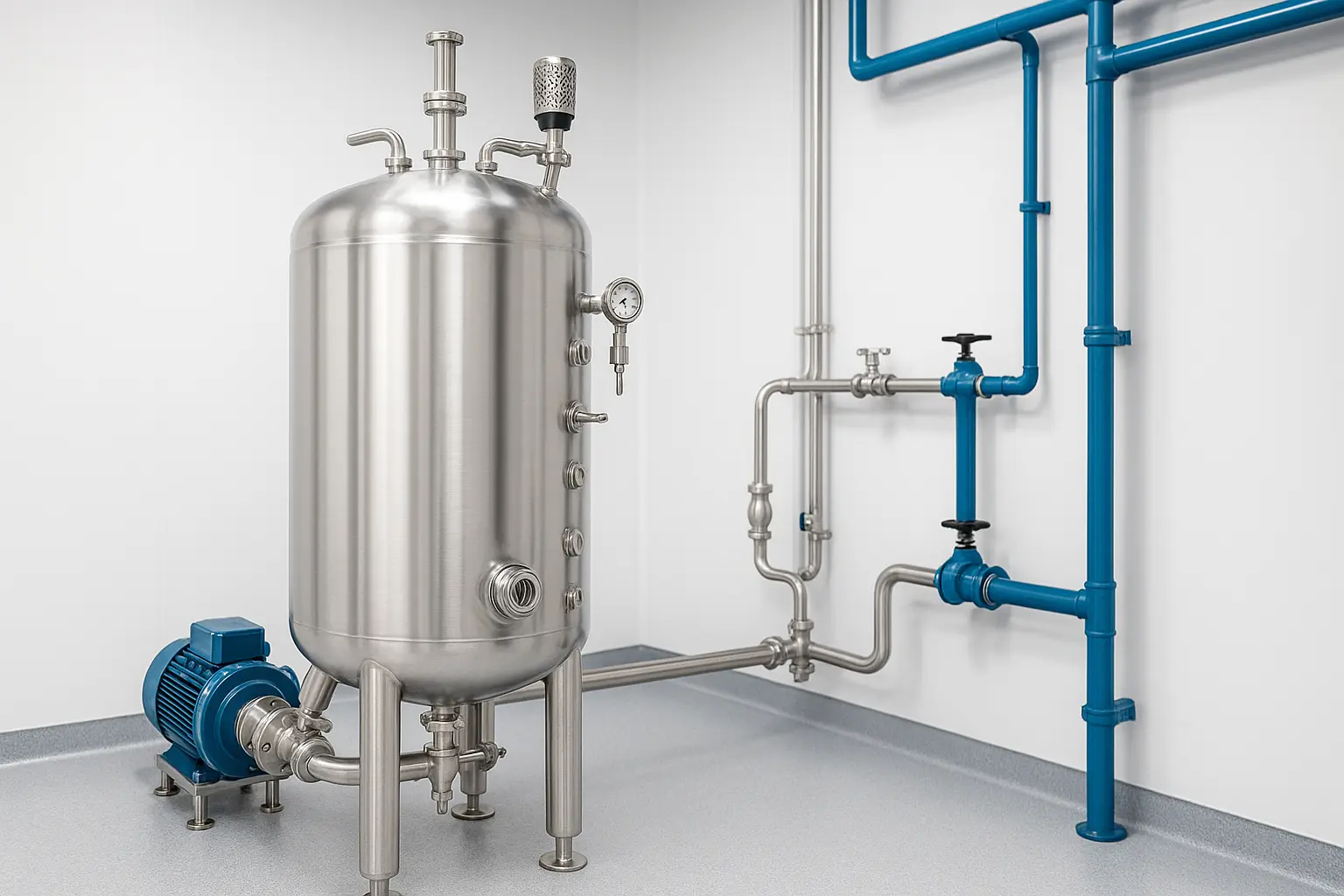Quick, audit-ready fundamentals for project engineers.
This 10-minute guide explains what a stainless steel purified water tank is, where it fits in your process train, and how to choose materials, size the working volume, design hygienic nozzles, and verify CIP/SIP. Use it to scope B2B projects faster, keep validation teams happy, and shorten RFQ cycles.
Related playbooks: reverse osmosis water treatment system, EDI vs mixed bed polishing, CIP/SIP stainless steel filter housings, and our ステンレス製品.
1) Where a stainless steel purified water tank fits in the process
Most industrial purified water systems follow: Pretreatment → RO (single or double pass) and/or EDI → stainless steel purified water tank → distribution loop with a sanitary pump, UV/TOC monitor, and return line. The tank decouples production from demand, prevents pump short-cycling, and stabilizes temperature and carbon dioxide (CO2) before water reaches points of use.
- Upstream: RO/EDI produces permeate/polished water at steady flow.
- Tank: provides surge, mixing, degassing, instrumentation and a hygienic hold-up volume.
- Downstream: loop recirculates at 1–1.5 m/s (typ.), keeping biofilm risk low and ensuring fast response at taps.

2) Materials & hygiene: 316L vs 304, finishes, gaskets
Choose 316L when chloride or low TOC risk matters; choose 304 when budgets are tight and chemistry is benign. Inside the stainless steel purified water tank, specify a smooth finish (e.g., Ra ≤ 0.4–0.8 µm, per industry/validation needs).
- 316L vs 304: 316L (Mo) offers better pitting resistance; 304 is cost-effective.
- Surface finish: mechanical polish plus passivation or electropolish; verify Ra on certificates.
- Seals: EPDM, PTFE or FKM depending on CIP chemistry and temperature windows.
- Hygienic details: self-draining heads, crevice-free welds, tri-clamps, short dead-legs (<2D/3D where applicable).
3) Sizing the tank: working volume, surge, NPSH & turnover
Start from the peak draw profile and add buffer (surge + CIP/cleaning allowance). The stainless steel purified water tank must provide enough NPSH to the distribution pump and guarantee minimum turnover (e.g., 24 h or as required).
Rule-of-thumb workflow
- Working volume ≈ Peak demand (m³/h) × required buffer time (h) + cleaning/maintenance allowance.
- Turnover ≥ operations requirement (e.g., once per day), else reduce volume or raise loop flow.
- NPSH & headspace: maintain flooded suction; avoid vacuum collapse during rapid draws.
Example A — Beverage plant
Peak 8 m³/h for 20 min bursts plus base 2 m³/h. Buffer 30 min. Working volume ≥ 8×0.33 + margin ≈ 2.6–3.0 m³.
Example B — Electronics UPW loop
Steady 3 m³/h + occasional 5 m³/h CIP feed. Minimum turnover once per 24 h. Tank 2.5–3.5 m³ supports both cases.
4) Nozzle & internals: inlet, outlet, spray ball, vent, drain, level
Hygienic nozzle layout is critical. A validated spray device (fixed spray ball or rotary) must reach all wetted surfaces. The vent must include a sterilizing grade hydrophobic filter (commonly 0.2 µm) with heat jacket if condensation is likely.
- Inlet/outlet/recirculation: position to encourage sweeping flow and mixing; avoid dead zones.
- Drain: full-drain bottom with steep cone/dished head; prove no liquid hold-up.
- Instrumentation: level, temp, conductivity/TOC, pressure/vacuum relief; hygienic sight glass optional.
- Spray device: coverage test or riboflavin tests for high-risk applications.
5) Headspace & contamination control
The headspace above purified water is where condensate and aerosols can seed problems. For a stainless steel purified water tank, use a heated vent filter or inert gas overlay when temperature swings are large.
- Vent filter: 0.2 µm PTFE/PVDF cartridge with integrity testing and scheduled changeout.
- Condensation control: insulation, heat tracing, or gentle headspace heating to prevent “rain-in-tank”.
- Thermal regimes: ambient loops may add periodic pasteurization; hot loops rely on continuous 65–80 °C.
6) Controls, alarms & documentation
Keep controls simple, visible, and well-logged. Typical interlocks: low level → pump stop; over-pressure → relief; high temp/TOC/conductivity → alarm and divert to drain. Good documentation shortens audits.
- Trending: level, temperature, TOC, conductivity, ΔP across vent filter, loop flow & return temperature.
- Records: receiving inspection, surface finish certificates, pressure tests, passivation/electropolish reports.
- Validation (as applicable): IQ/OQ/PQ pack, cleaning coverage, and vent filter integrity traces.
7) Installation & O&M quick notes
- Anchor & isolate vibration; protect polishing on site; verify no weld discoloration after tie-ins.
- Minimize dead-legs; keep all branches short and self-draining toward the stainless steel purified water tank.
- Service schedule: spray device inspection, vent filter integrity, passivation check, gasket rotation, sight-glass O-rings.
8) Purchasing checklist (BOM) & RFQ template
Copy/paste this into your next RFQ and attach your P&ID:
- Tank body: volume (working/total); 316L or 304; head type (cone/dished); self-draining design.
- Finish: inside Ra target (e.g., ≤0.6 µm), passivation/electropolish, weld maps and certificates.
- Nozzles: inlet/outlet/recirculation, drain, spray ball, vent with 0.2 µm filter, temp/level/TOC ports.
- Accessories: insulation & cladding, heat tracing, manway type, ladder/handrails if vertical.
- Testing: hydro/pressure tests, surface finish verification, documentation pack.
- Delivery & scope: skids/pumps/loop options; FAT/SAT; start-up and training.
Looking for a quotation or a matching distribution loop? Visit our ステンレス製品 または 見積依頼.
9) FAQs
Do I need 316L or is 304 acceptable for RO permeate?
For most neutral RO permeate, 304 can work; choose 316L if you have elevated chlorides, aggressive CIP chemistry, or stringent validation/UPW expectations.
What inside finish is typical?
Food & beverage often target Ra ≤0.8 µm; pharma/electronics push Ra ≤0.6 or ≤0.4 µm with passivation/electropolish.
How do I size the vent filter?
Calculate worst-case air in/out during fast fill and rapid draw; add safety margin; verify thermal rating and integrity testing method.
Can one tank feed both RO and EDI loops?
Yes, with careful hydraulics and valve logic; avoid cross-contamination and maintain turnover in each loop.
Vertical or horizontal orientation?
Vertical saves footprint and drains well; horizontal fits low headroom and can improve mixing in some layouts.
Summary
A successful stainless steel purified water tank project balances hygienic construction (materials/finish/drainability), water-hydraulics (volume, turnover, NPSH), and verifiable CIP/SIP. Nail these three, and commissioning becomes routine.
Related resources
- RO membrane housing diagram
- RO commissioning checklist
- Chlorine CT & dosage calculator
- CIP/SIP for stainless housings

